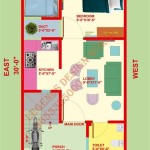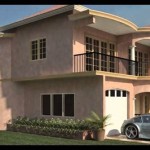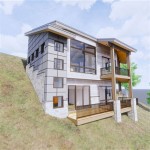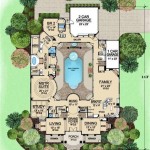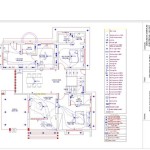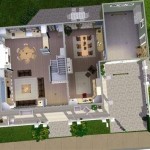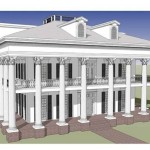House Floor Plans With Attached RV Garage: A Comprehensive Guide
The integration of recreational vehicle (RV) garages into residential house plans represents a growing trend, driven by the increasing popularity of RV travel and the desire for convenient, secure storage of these large vehicles. House floor plans with attached RV garages cater to a specific demographic: individuals or families who own RVs and prioritize easy access, protection from the elements, and potentially, a dedicated space for RV maintenance and preparation. This article examines the key considerations, benefits, design variations, and potential challenges associated with incorporating an RV garage into a house plan.
Key Considerations Before Design
Prior to embarking on the design process, several crucial factors must be evaluated to ensure the RV garage effectively meets the homeowner’s needs and complies with local regulations. These considerations directly impact the garage’s size, layout, and integration with the rest of the house.
RV Dimensions: The most fundamental aspect is determining the precise dimensions of the RV to be accommodated. This includes the overall length, width (including extended mirrors), and height (including roof-mounted accessories like air conditioners or satellite dishes). Accurate measurements are critical for ensuring the RV can comfortably fit inside the garage with sufficient clearance for maneuvering and maintenance. It is prudent to consider the potential for future RV upgrades and design the garage with some extra space to accommodate larger models.
Door Height and Width: The garage door opening must be adequately sized to allow the RV to pass through without scraping or damaging the vehicle. Standard residential garage doors are typically insufficient. RV garages require significantly taller and wider doors, often ranging from 12 to 16 feet in height and 10 to 14 feet in width. The type of door (e.g., sectional, roll-up) should also be selected based on space constraints and aesthetic preferences.
Local Zoning Regulations and HOA Restrictions: Local zoning ordinances may impose restrictions on the size, placement, and appearance of accessory structures, including RV garages. Height limits, setback requirements, and architectural guidelines must be carefully adhered to. Homeowner's Associations (HOAs) often have their own sets of rules regarding the design and use of RV garages, potentially dictating materials, colors, and even prohibiting their construction in certain communities. Compliance with these regulations is mandatory to avoid costly penalties or legal issues.
Site Topography and Accessibility: The slope and terrain of the property can significantly influence the design and cost of an RV garage. A sloped site may require extensive excavation or retaining walls to create a level parking surface. Adequate access for bringing the RV in and out of the garage must be ensured, considering turning radii and potential obstructions. The location of existing utilities (e.g., sewer lines, water pipes) should also be factored into the site plan.
Budget Considerations: Constructing an RV garage is a significant investment. Costs vary depending on the size of the garage, the materials used, the complexity of the design, and local labor rates. It is essential to establish a realistic budget early in the process and obtain multiple bids from qualified contractors. Planning for potential cost overruns and unexpected expenses is also advisable.
Benefits of Integrating an RV Garage Into a House Plan
Incorporating an RV garage offers numerous advantages, enhancing both the convenience and value of a home for RV enthusiasts. These benefits extend beyond mere storage, contributing to improved vehicle maintenance, security, and overall lifestyle.
Protection from the Elements: An RV garage shields the RV from harsh weather conditions, including sun exposure, rain, snow, and hail. This protection helps prevent fading, cracking, and other forms of weather damage, extending the lifespan and maintaining the resale value of the RV. It also reduces the need for frequent washing and waxing.
Enhanced Security: Storing an RV inside a locked garage provides a significant level of security, deterring theft and vandalism. An attached garage allows for direct access from the house, eliminating the need to venture outside in inclement weather or at night. The garage can also be equipped with additional security features, such as motion sensors, alarms, and security cameras.
Convenient Access for Maintenance and Preparation: An RV garage provides a dedicated space for performing routine maintenance tasks, such as checking fluids, cleaning the interior, and preparing for trips. Having the RV readily accessible allows for more frequent and thorough maintenance, helping to prevent mechanical problems and ensure safe operation. The garage can also be equipped with electrical outlets, water hookups, and compressed air lines to facilitate maintenance activities.
Additional Storage Space: Beyond RV storage, the garage can serve as valuable storage space for camping gear, outdoor equipment, tools, and other items. Custom shelving, cabinets, and overhead storage racks can be installed to maximize storage capacity and keep the garage organized. This helps to declutter the main house and provides a convenient place to store items related to RV travel.
Potential for Workshop or Hobby Area: With adequate space and proper ventilation, the RV garage can be transformed into a workshop or hobby area. This provides a dedicated space for woodworking, metalworking, automotive repairs, or other hobbies. The large size of the garage allows for accommodating large equipment and machinery. Adding insulation and climate control can make the space more comfortable for year-round use.
Design Variations and Integration Strategies
RV garages can be integrated into house plans in a variety of ways, each offering different aesthetic and functional characteristics. The choice of design depends on the homeowner's preferences, the architectural style of the house, and the available space on the property.
Attached RV Garage: The most common approach is to attach the RV garage directly to the main house. This provides convenient access and allows for a seamless integration of the garage into the overall design. The garage can be attached to the side, rear, or front of the house, depending on the site layout and architectural considerations. A connecting door or hallway can be added to provide direct access from the house to the garage.
Detached RV Garage: A detached RV garage is a separate structure located on the same property as the main house. This option provides more flexibility in terms of placement and design. A detached garage can be positioned to maximize the use of the land or to create a specific aesthetic effect. It also reduces the potential for noise and fumes from the garage to enter the house.
Drive-Through RV Garage: A drive-through RV garage has doors on both ends, allowing the RV to be driven straight through. This can be particularly useful for properties with limited space or challenging access. The drive-through design eliminates the need for backing up the RV, making it easier to maneuver. It also provides better ventilation and allows for more natural light.
RV Port: An RV port is a covered structure without enclosed walls, providing protection from the elements without the security of a fully enclosed garage. This can be a more cost-effective option, but it offers less protection from theft and vandalism. RV ports are often used in warmer climates where protection from the sun is the primary concern.
Incorporating Living Space Above or Beside: The space above or beside the RV garage can be utilized for additional living space, such as a guest suite, home office, or recreational room. This can be a cost-effective way to add square footage to the house. Careful planning is required to ensure that the living space is properly insulated and soundproofed from the garage below.
Designing house floor plans with attached RV garages involves a complex interplay of factors, encompassing RV dimensions, local regulations, design preferences, and budgetary considerations. While offering significant advantages such as enhanced security, protection from the elements, and convenient maintenance, proper planning and execution are crucial to ensure the RV garage seamlessly integrates into the overall house design and fulfills the homeowner's specific needs. The integration of such specialized spaces enhances the functionality and value of a home, catering specifically to the lifestyle of RV enthusiasts.

Storage Solutions Rv Garage Plans And More Houseplans Blog Com

Viejo 2 Car With Rv Option Dbu Homes

Rv Garage Plans With Incredible Storage Blog Dreamhomesource Com

Rv Garage Home Floorplan We Love It House Plans Pole Barn Floor

Rv Garage Plans With Incredible Storage Blog Dreamhomesource Com

Ranch Home With Rv Garage 35423gh Architectural Designs House Plans

Sunset Harbor Ii Floorplan Garage House Plans Small Floor

Plan 006g 0160 The House

House Plan 85371 With 3304 Sq Ft 3 Bed Bath

50x48 1 Rv Garage Br 5 Ba Floor Plan 2274 Sq Plans Barndominium Pole Barn House

